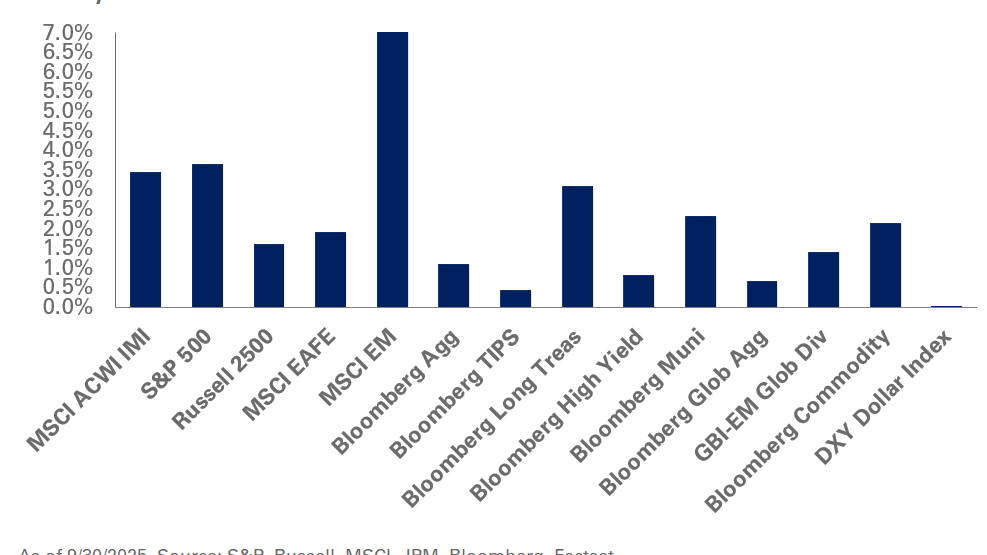Escalating geopolitical turmoil in the world and a strengthening U.S. dollar are heightening currency volatility, leading to a renewed focus on foreign exchange risk in investments. We turn to NEPC CIO Timothy F. McCusker to understand the implications of currency hedging within investment portfolios and the investors that will benefit from it. Spoiler alert: it’s not for everyone!
1. In the simplest terms, what is currency hedging?
Foreign currency hedging is an attempt to manage the volatility that comes from having investment exposures denominated in currency other than U.S. dollars. So, if you are an U.S. investor and your liabilities or spending needs are in dollars, you want your assets to grow in dollars so that you don’t have a a mismatch.
You want to balance this against the benefits of an investment portfolio that is well diversified, including diversification across different geographies. There are real benefits to having these varied exposures in your portfolio as they behave differently than U.S.-based investments.
The challenge is that the currency exposure that comes from these investments can add volatility without providing a risk premium or compensation for holding that risk over time. Over the long term, currencies tend to net out to to a zero difference and, therefore, you’re taking on 8% to 10% volatility from holding these currencies without getting an incremental return.
Currency hedging is offsetting that volatility by converting those non-U.S. exposures into dollar terms, so you’re not taking on that currency risk. NEPC has conducted substantial research over the years on the benefits of currency hedging. Generally, we are advocates for hedging certain foreign currency exposures. Currency hedging allows you to take risk somewhere else in your portfolio and bring your risk back up into an asset that you think will compensate you for taking that risk.
2. Can you address currency hedging in the context of the current geopolitical turmoil in the world?
Our thoughts on currency hedging are not with a particular view of the direction of geopolitics, but it is in line with the view that geopolitical risk is likely to be higher in this new investment regime compared to the last 20 or 30 years where we had a world of global cooperation.
When you have geopolitical uncertainty, there’s an expectation of the unexpected…of surprising events. You don’t know what those events will be, but there is the expectation that there will be these big events, for instance, the Russian invasion of Ukraine, or the Hamas attack on Israel. When those events happen, you can often see big currency moves—strengthening or weakening—depending on the event. In these situations, having currency hedges can really protect you because you can get big debasements in currencies depending on the geopolitical event that’s playing out and, with the U.S. dollar being a reserve currency, you’d rather hold your assets in dollars.
3. What are the drawbacks to currency hedging?
The biggest drawback is that it’s complex. First, you’ve got to understand and make sure it makes sense for your particular investment situation, return objectives and constraints.
Implementation is not simple either. You typically hedge currency risk through derivative contracts, using currency forwards and futures. You also have to be constantly aware of how your underlying currency hedges line up with your underlying exposure as your non-U.S. dollar-denominated investments move over time. I don’t want to say you have to actively manage those risks, but they do require regular maintenance and management, so you don’t have a mismatch.
4. When does it make sense to hedge currency within investment portfolios?
There are a few steps that you’ve got to go through and there are a number of decision points.
First, you have to decide if, philosophically, you believe what we believe at NEPC, which is that currency risk is not compensated, and if you want to take that risk off the table.
I think we can all agree that currency exposure adds volatility. That is mathematically true, and we can start there. There is some debate, depending on the time horizon you look at, whether you are rewarded for taking on foreign currency risk. We have done a lot of work there and believe that it nets out to basically neutral. There is also extensive academic and practical research that shows there isn’t a longterm risk premium.
Second, you must assess how much foreign currency exposure you have in your portfolio and the type of exposure. Let’s say just 10% of your portfolio is in non-U.S. investments. That might be a small enough risk exposure that it’s not worth the effort to manage that little bit of currency risk that comes with it.
Now, if you are a typical well-diversified investor and you’ve got 25% to 40% of your portfolio in non U.S. investments, then probably those currency exposures are adding risk, and you have to think about the cash flows that come with implementing a currency hedge through derivatives.
Here, it gets to what type of investor you are. The cash flows may not matter at all if you are an institutional tax-exempt U.S. investor, and you probably have the resources or can hire a manager to manage those cash flows for you.
If you are a taxable investor, whether private wealth or an insurance company, or have some other type of taxable entity, those cash flows that come in when you have underlying gains from your currency hedges are taxable. That offsets many benefits of currency hedging because you may not be realizing the underlying losses in the non-U.S. investments portfolio you have. So, you have a tax mismatch with the cash flows. That really complicates things. In general, we would say it doesn’t make sense for private wealth investors and other taxable investors to undertake currency hedging.
Another decision point related to currency hedging is to consider exposure to developed versus emerging markets. We think there are many benefits to hedging your developed markets foreign currency exposure. While you may have meaningful emerging markets currency exposure in your portfolio, the transaction and carry costs of hedging foreign currency of emerging markets is much more expensive. So, we tend not to recommend hedging emerging markets exposure and just recommend hedging exposure to developed market currencies.
Through our research, we have also concluded that you can get two-thirds to three-fourths of the benefit of the risk reduction from hedging half the currency exposure—and not all the currency exposure—and it also reduces the volatility around cash flows.
While on the topic of considering currency hedging, I should also mention exposure to illiquid investments. You may have a lot of private equity exposure outside the U.S. and, while that can have meaningful swings in your outcome because of the currency exposure, we typically don’t recommend hedging that exposure because of the timing mismatch. You’ll have to take on cash flows of gains and losses in a currency hedge, but you may wait five-, seven- to 10-years to realize the outcome on those underlying investments. So, currency hedging doesn’t make sense in the same kind of way.
5. How is currency hedging implemented in investment portfolios?
You typically use derivatives to implement it, so that’s the underlying structure. Large, sophisticated investors may have an overlay manager managing a futures program and that manager can typically add on currency hedging to what they are already doing. It’s a smaller subset of investors that have this type of manager in their roster. It’s a big undertaking for a small-to-mid-size investor to add an overlay manager and, probably, there aren’t many benefits to doing it.
At NEPC, we have arrived at an elegant solution to this: We have gone to some of our favored international equity managers because international equities are where you see more of the currency risk, and we’ve asked them to use their active management capabilities. They are not changing the way they pick the underlying stocks but adding a currency hedging component to what they do—a 50% hedge—and building a separate fund, so that all that currency hedging happens within a fund, just like you would invest in an international equity manager managing to an EAFE benchmark. We have also worked with index providers to offer currency hedged MSCI EAFE funds so investors can calibrate their foreign exchange hedge percentage by allocating between unhedged and hedged allocations. In both instances, the hedging happens within their portfolio, so you don’t have to manage the cash flows, and the mechanics that come with that happen within a manager’s fund.
6. How do movements in the U.S. dollar affect currency hedging?
We have been through a long-term regime of a strengthening U.S. dollar. Globally, currencies are a zero-sum game, and that’s why, collectively, there’s no risk premium worldwide for them if the dollar is strengthening. When we talk about dollar strength, we’re typically talking about the dollar relative to a basket of developed market currencies.
It’s not the same percentage exposures but think of it roughly as the the basket of currencies you get from an EAFE Index of international equities. So, a strong dollar means weak foreign currencies. For instance, if you got a 10% return from EAFE equities in local terms, but over that same time the dollar has strengthened by 5%. That means the foreign currencies that you’re holding have weakened by 5%.
So, you only got a 5% return instead of a 10% return. If you were hedging that exposure at the same time those currencies were weakening because you own them in that international equity investment, you are selling them with your derivatives contracts to offset that exposure or you’re at least selling half of it if you’re hedging half your foreign currency exposure. So, you would get 2.5% of that 5% back through your currency hedging and make up some of the difference. The reverse is true if the dollar is weakening, and those underlying foreign currency exposures are strengthening. In that case you’d rather not be hedged. But it’s not a tactical decision for NEPC clients to hedge sometimes and not others.
You will win and lose over time, but net-net you will reduce the volatility of those investments, make those underlying international equity investments more efficient such that you’re able to take more risk somewhere else in your portfolio.
7. How can NEPC help?
First and foremost, we can help you with the process of evaluating your foreign currency exposure in your portfolio. It’s important to first know what you have and NEPC has tools available to look through your exposures and understand the total underlying exposure and figure out whether it’s material enough to take on currency hedging. We also have educational materials around currency hedging if you want to get up to speed on that.
To the extent that you have meaningful currency exposure to developed markets that you want to address, we have tools available to implement hedging. We have relationships and we’ve underwritten one-rating overlay managers that can implement these currency hedges for clients where appropriate. We also have one-ratings on hedged international equity active and passive products that can be implemented; these are simplified, cleaner solutions to currency hedging.
With a diverse client base across client types, we understand the objectives and constraints of different types of investors. As a result, even if you have material exposure, we can have the conversation around whether currency hedging makes sense for your portfolio after thinking through all the complexities. Please reach out to your NEPC consultant if you have any questions. We will be happy to share more details about our process and thoughts on currency hedging.



